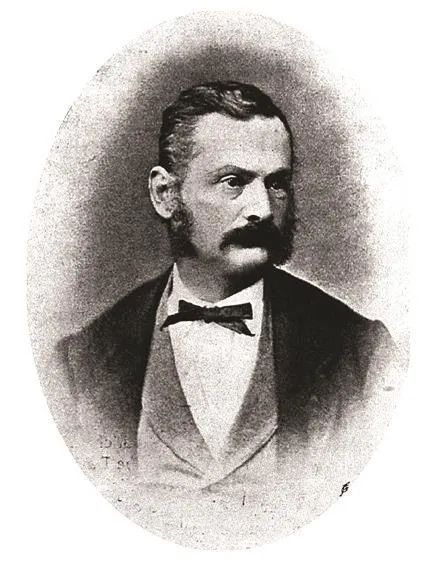Prof.Friedrich Haberlandt-the Pioneer of Soybean in Europe
Georg Weissenböck,Dennis Böhmer,Leopold Rittler
(1.Institute of Rural History,3109St.Pölten,Austria;2.University of Natural Resources and Life Sciences,Vienna.Institute for Plant Breeding,3430 Tullnander Donau,Austria;3.Donau Soja Organisation,1010 Vienna,Austria)
One can hardly overestimate the impact of Friedrich Haberlandt on the introduction of soybeans in Europe.His life is an archetype of an influential multinational academic in the Austrian-Hungarian Empire of the 19th century.After first finding out about the soybean in 1873,he was the first to conduct systematic trials with soybeans in Europe.He distributed his knowledge to experts and users in many countries.In his vision of the potential of soybeans for European farmers and for feeding the growing population,he predicted developments,which took place many generations after his early death.Although seemingly unsuccessful at first sight,his efforts formed a crucial starting point for the effective integration of soybeans in the Western Hemisphere.

Friedrich Haberlandt was born on February 21st in 1826in Preßburg,now known as Bratislava,the capital of modern Slovakia (Shurtleff/Aoyagi 2008). Because his father, Gottlieb Haberlandt, was a craftsman in a German speaking community, he grew up in a tri-lingual environment learning Hungarian and Slovak languages in his youth alongside German. He finished high school in his hometown where he also studied law for one year. He was a liberal and even volunteered in the revolution of 1848. He completed his studies in natural sciences at the establishment of higher education in Ungarisch- Altenburg (Mosonmagyaróvár in modern Hungary)where he also started his academiccareerasan assistant professor. His thinking was highly influenced by the revolutionary works of scientists such as Justus von Liebig at that time. He lived in a time of fundamental technological and economic change. Rationalization processes and scientific knowledge were applied to many areas of society such as agriculture and diet (Kingsbury,2009).In 1853,Friedrich Haberlandt married Katharina Köhler.They had three daughters and three sons.His oldest son,Gottlieb Haberlandt(1854)became a famous botanist.Another son,Michael Haberlandt(1860)became an outstanding ethnologist and founded the museum for ethnology in Vienna in 1895.Friedrich Haberlandt was appointed professor for mathematics,zoology,botany and agricultural production in 1854.During the following period,he developed his distinct interest and sensitive talent for observation and an extensive activity in scientific networks(Haberlandt 1933).He left the college in 1869 after the Austro-Hungarian Compromise.In Görz(Gorizia/Gorica in modern Italy and Slovenia),he founded and led a research centre for silkworm breeding.When the first agricultural college in Austria,theHochschule für Bodenkultur(the current University of Natural Resources and Life Sciences,Vienna)was founded 1872,Haberlandt was appointed outright professor,and later became rector of the university.He kept this position until his death in 1878.In the course of his research,he worked extensively on the soybean as a protein supplier.
【参考译文】
弗里德里希·哈伯兰德教授——欧洲大豆业的先驱
对于弗里德里希·哈伯兰德(Friedrich Haberlandt)教授将大豆引进到欧洲所带来的巨大影响,无论给予多高的评价都不过分。他是19世纪奥匈帝国一位极具影响力的跨国界学者。1873年,当首次认知大豆后,他成为欧洲进行大豆系统试验的第一人,并向多国专家和用户传播大豆知识。他虽英年早逝,但他的关于大豆种植将对欧洲农民产生的潜在重要性,以及养活不断增长的人口方面所做出的准确预测和展望,深深地影响了其后的几代人。尽管他的初始研究似乎并不成功,但他的努力成为了西半球大豆综合研究的有效且关键的起点。
弗里德里希·哈伯兰德,1826年2月21日出生于前堡,现称布拉迪斯拉发,是现今斯洛伐克的首都。他的父亲,戈特利布·哈伯兰德,在一个讲德语的社区里作工匠,他因而得以在一个有三种语言的环境中长大。年轻的时候,除了精通德语,他还会说匈牙利语和斯洛伐克语。他在家乡读完高中,并在那里学了一年的法律。他是个自由派,甚至自愿参加了1848年的革命。
他在不加里斯-奥尔滕堡(现今匈牙利的Mosonmagyaróvár)接受高等教育,并完成了自然科学研究,在那里他还开始了作为助理教授的学术生涯。当时,他的思想很大程度上受到如尤斯特斯·冯·李比希(Justus von Liebige)等科学家们开创性著作的影响。他生活在一个技术和经济发生根本性变革的时代,当时,变革进程和科学知识已应用于社会许多领域,诸如农业和饮食等(Kingsbury,2009)。1853年,弗里德里希·哈伯兰德与凯瑟琳·科勒结婚,他们育有三女三子。他的长子Gottlieb Haberlandt出生于1854年,后来成为一位著名的植物学家。另一个儿子Michael Haberlandt出生于1860年,后来成为一位杰出的民族学家,并于1895年在维也纳建立了民族学博物馆。
1854年,弗里德里希·哈伯兰德被聘为数学、动物学、植物学和农业生产学的教授。在随后的时期,由于他独特的兴趣和敏锐的观察力,在许多科学研究领域,他都开展了广泛研究(Haberlandt,1933)。1869年,在奥匈帝国妥协签订之后,他离开了他就职的学院,在Görz(现今意大利和斯洛文尼亚的Gorizia/Gorica),他创建并领导了一个丝蚕育种研究中心。当奥地利第一所农学院,即目前的维也纳自然资源和生命科学大学1872年成立时,他被直接任命为教授,后来成为该大学的校长。此后,他一直担任这一职务,直到1878年不幸离世。在他的研究过程中,他把大豆作为重要的蛋白质原料进行了广泛研究。

